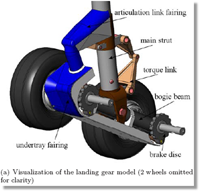A study was performed to investigate and optimize the application of perforated fairings for landing gear noise control. The sparse knowledge about this new subject has necessitated a more fundamental study involving a basic fairing-strut configuration, followed by wind tunnel tests on a simplified landing gear configuration incorporating perforated fairings. The synthesis of the conducted studies has shed new light on application of perforated fairings for landing gear noise control.

Landing gear noise can be the dominant component of airframe noise, especially for larger aircraft. The interaction of the airflow with protrusions and cavities gives rise to unsteady flow phenomena constituting a potent sound generating mechanism. Shielding landing gear components with fairings and thereby preventing this interaction has been considered before. High speed flow deflection onto other components and fairing self-noise are disadvantages of these fairings. Bleeding air through the fairings by making them porous can reduce the impact of these effects and result in a noise reduction.
To investigate and optimize the application of perforated fairings for landing gear noise control.
The aerodynamics and acoustics of a strut shielded by various perforated fairings have been studied in the wind tunnel and using an open jet. Armed with the lessons learned from this experiment, a 0.25 scale landing gear model incorporating perforated fairings has been designed and tested in the wind tunnel.

Bleeding air through the fairings is shown to reduce the formation of large scale unsteadiness associated with the fairings. As a result the low frequency noise decreases. Application of perforations outside the stagnation area does not effect the low frequency noise but introduces adverse high frequency noise due to the shearing flow past the perforations.